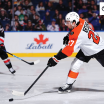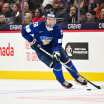If the Philadelphia Flyers are to continue contending for a top spot in the Eastern Conference come the 2020-21 NHL regular season and then parlay it into a deeper run in the 2021 Stanley Cup playoffs, they will need to maintain or subtly improve upon various areas of their game.
MELTZER: Inside the Numbers for 2020-21
Flyers contributor looks at five areas to pay attention to next season

By
Philadelphia Flyers
philadelphiaflyers.com
The good news is that the team, over the past year, displayed vast improvement from where they were before 2019-20. What's needed now is more in the way of fine tuning -- or, in some cases, maintaining the status quo -- than large-scale adjustments. The coaching staff and the systems are now established, and there was a track record of success when executed.
Here are three major areas the Flyers improved this past season, and must either maintain or build upon from last season.
1. TEAM GAA
During the 2018-19 season, none of the NHL's bottom-10 teams in goals against average (and just two of the bottom 14 teams) made the playoffs. The two playoff teams among the bottom 14 in GAA were the Toronto Maple Leafs (20th, 3.04 GAA) and San Jose Sharks (21st, 3.15 GAA).
Conversely, there were two teams in the goals-per-game top-10, the Chicago Blackhawks (8th, 3.26 GPG) and Florida Panthers (9th, 3.22 GPG) who failed to qualify for the postseason in 2018-19.
In 2019-20, at the time of the leaguewide pause and before the expansion of the postseason from 16 to 24 teams, only three teams in the NHL's bottom-13 in goals against average were in playoff position -- the Nashville Predators (T-19th, 3.10 GAA), Vancouver Canucks (T-19th, 3.10 GAA) and Toronto Maple Leafs (T-25th, 3.17 GAA). Meanwhile, two teams in the goal-scoring top 10 -- the New York Rangers (5th, 3.33 GPG) and Florida (6th, 3.30 GP) were below the postseason cutoff line at the time of the pause.
Last season's Stanley Cup champion, the St. Louis Blues, ranked 15th in goals per game at 2.98 during the regular season. They were 5th in GAA (2.68). This year, the Dallas Stars ranked 26th in regular season goals per game during the regular season (2.55 GPG) but 2nd in goals against average (2.44 GAA). The New York Islanders, who later reached an overtime Game 6 of the Eastern Conference Final, ranked 22nd in GPG but 9th in GAA.
The point here is that team depth, team defense, and goaltending are more important to getting a team into the postseason than how many goals a team scores.
The Flyers improvement this season was largely steeped in lowering the team GAA from 3.41 (29th) to 2.77 (7th). If the club can do that again in 2020-21, or hopefully even improve upon it to the range of a 2.65 or below (which would get the Flyers into the league's top five or so), the team will be well set up to once again be a top team in the East.
There's no reason to believe the Flyers are not capable of doing this. Carter Hart is one of the league's best young goaltenders, the blue line (with the exception of Matt Niskanen and current unrestricted free agent Justin Braun, who may not be returning) is still young but also has some NHL experience under its belt at this point. Forwards largely bought in during the 2019-20 season to skating shorter shifts (three seconds per shift on average compared to 2018-19) and paying attention to off-puck detail.
Let's break it down a little further:
* Shot suppression: No team in the entire NHL allowed fewer shots in goal during the 2019-20 regular season than the Flyers. An average of 28.7 per game. In 2018-19, the Flyers allowed 32.5 per game on average to rank 22nd. In the 2020 Stanley Cup playoffs, the Flyers backslid to allowing an average 30.6, whereas all but one of the four teams that reached the Eastern/Western Conference Finals improved upon their regular season shots allowed averages. The outlier is the Dallas Stars, who allowed 31.6 shots on goal on average in the regular season and have allowed 33.1 so far in the playoffs.
* Third period performance: Statistically, third periods were the Flyers' best period during the 2019-20 season, Philly outscored its opponents in 3rd periods by a margin of 87-61 across 69 games (conversely, the Flyers were outscored in 1st periods, 61-68, but improved to +14 in second periods at 74-60). With so many games around the NHL up for grabs entering third periods, being a strong third-period club is typically a good predictor of which teams will be near the top of the standings in their Division or Conference and which will be on the playoff bubble or below the cutoff. Unfortunately for the Flyers in the Islanders series, third periods were problematic as they got outscored, 11-3.
* Closeouts: This goes hand-in-hand with third period goal differentials but merits attention of its own. The Flyers took leads in the third period in 31 regular season games this season, and did not lose a single one of those games in regulation; a 29-0-2 record and .935 winning percentage. In the postseason, the Flyers went 9-0 when leading after two periods but it must be noted that the Flyers lost multi-goal leads twice in third periods in the Islanders series but managed to win those game in overtime. During the Montreal series, Philly's closeouts were vital to their 2-1 (Game 1), 1-0 (Game 3), 2-0 (Game 4) and 3-2 (Game 6) victories that carried the team through to Round 2.
* Puck possession and shot quality: The Flyers were on the positive side of the ledger in both 5-on-5 total shot attempt differentials (ranked 9th) and in high/medium danger scoring chance differentials (ranked 15th) during the regular season. In the fateful Islanders series, the Flyers actually attempted more 5-on-5 shots than the Islanders (not getting them blocked or missing the net was another matter) but the Islanders had the better scoring chances by nearly a 55 percent to 45 percent margin.
2. SCORING DEPTH
As set forth above, a team's goals against average in the regular season is more reliable predictor of likelihood of making the playoffs than it's team goals per game average. Even the most high powered offenses run cold at times -- a hot goalie on the other side can also be a tremendous equalizer -- and teams that consistently need to score four or five goals to win are normally going to have issues getting into the playoffs and advancing in the postseason even if they do finish above the cutoff.
Nevertheless, the very best teams in hockey are clubs that have the ability to win a variety of different ways. Sometimes you do have to outscore some breakdowns and, against elite-grade opposition where you may play well defensively and still give up a few goals, it goes without saying that clubs that have offensive firepower of their own stand the best chance of prevailing in such games. Goalies and defenses need at least some margin for error, after all.
The Flyers did not have any players finish in the individual top 25 in scoring this past season, but they nonetheless really weren't hurting for goals in the regular season (or the round robin, for that matter). Philadelphia finished 7th in the league with an average 3.29 goals scored per game. This was accomplished through depth, including contributions from the defense corps and the middle six of the lineup on any given night.
Now the challenge will be to bump up a couple spots offensively, and especially to find scoring in the postseason. One of the oddities of the Flyers' playoff series with the Islanders was that Philly was actually quite opportunistic offensively in the three games they won in overtime, all by 5-4 final scores, but actually played better in their Game 3 and 4 losses while struggling to finish a higher volume and overall better quality of scoring chances. Normally, that'd be the other way around.
3. SPECIAL TEAMS
This has been mentioned many times already, for good reason: The Flyers, with the exception of a three-goal outburst in Game 5 of the Montreal series, were abysmal on the power play throughout the postseason. There was occasional bad luck but, overall, the process of generating entries, setting up plays with varying looks and actually getting shots on net when there were lanes left a lot to be desired.
In the regular season, the Flyers' power play's overall 20.8 success rate (14th in the NHL), was neither spectacular nor terrible. The team improved significantly from 2018-19, when they tied for 22nd in the league at 17.1 percent. The bigger issue this past season than percentage was excessive streakiness. The power play tended either to be red hot or ice cold for stretches with insufficient middle ground.
Unfortunately for the Flyers, the coldest streak of them all this season came in going 4-for-52 (7.7 percent) in the playoffs.
Many NHL coaches prefer to look at special teams from a composite standpoint that incorporates both the power play and the penalty kill. The Flyers greatly improved on the PK this season, with periodic hiccups that not surprisingly overlapped with the generally brief stretches where wins were hard to come by for the team. That spilled over into the playoffs, too. The PK was good overall but had some letdowns in playoff losses.
From a numbers standpoint, the Flyers had an 81.8 percent regular season success rate in the regular season (ranked 11th) and 80.8 percent in the playoffs. This was a big improvement from the Flyers' 26th-ranked 78.5 percent performance of 2018-19, when the team was actually at below 70 percent for the first 24 games of the season.
In the bigger picture, if you combine a team's power play and penalty killing percentages, anything below 100 (example: 20 percent PP plus 80 percent power play) is generally below average. Anything from 105 or above is very good. The Flyers special teams composite was 102.6 in the regular season, which is pretty solid. In the postseason, it dropped to 88.5, which is nowhere close to acceptable.


















